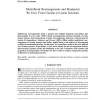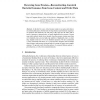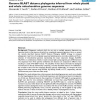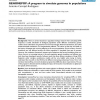73 search results - page 3 / 15 » Estimating Genome Reversal Distance by Genetic Algorithm |
JCB
2008
13 years 5 months ago
2008
Multi-break rearrangements break a genome into multiple fragments and further glue them together in a new order. While 2-break rearrangements represent standard reversals, fusions...
WABI
2004
Springer
2004
Springer
Reversing Gene Erosion - Reconstructing Ancestral Bacterial Genomes from Gene-Content and Order Data
13 years 11 months ago
In the last few years, it has become routine to use gene-order data to reconstruct phylogenies, both in terms of edge distances (parsimonious sequences of operations that transform...
RECOMB
2007
Springer
13 years 12 months ago
2007
Springer
Abstract. Genome doubling simultaneously doubles all genetic markers. Genome rearrangement phylogenetics requires that all genomes analyzed have the same set of orthologs, so that ...
BMCBI
2006
13 years 5 months ago
2006
Background: Phylogenetic methods which do not rely on multiple sequence alignments are important tools in inferring trees directly from completely sequenced genomes. Here, we exte...
BMCBI
2008
13 years 5 months ago
2008
Background: There are several situations in population biology research where simulating DNA sequences is useful. Simulation of biological populations under different evolutionary...




